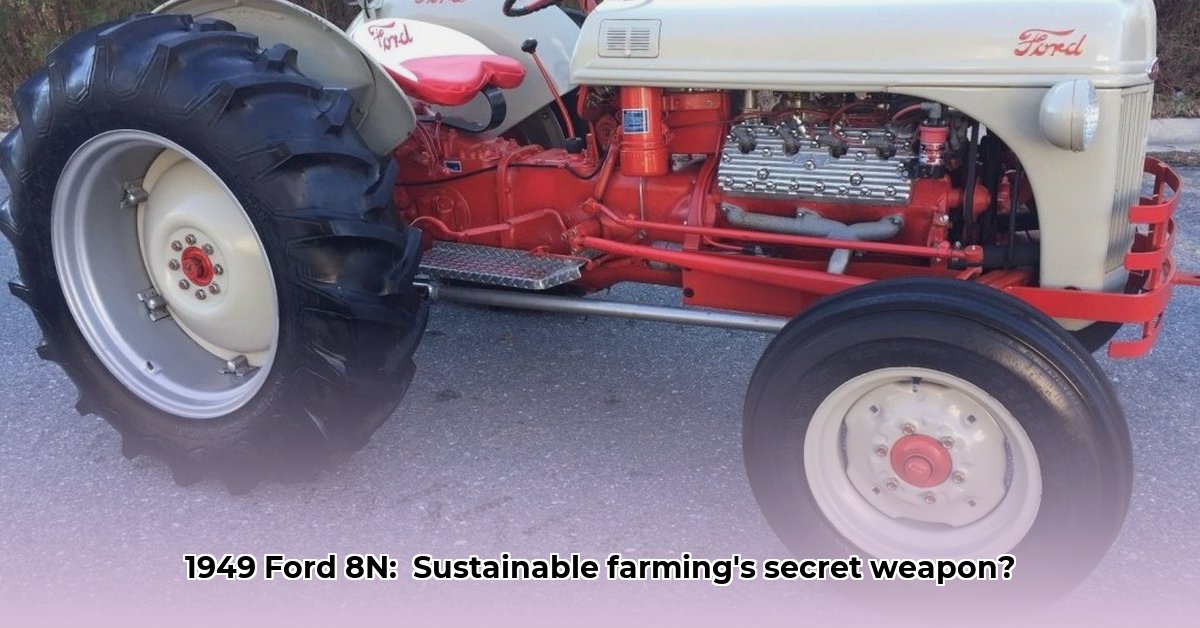
The 8N's Debut: A Post-War Powerhouse
The 1949 Ford 8N tractor, a pivotal machine in agricultural history, emerged from a post-World War II landscape defined by food shortages and labor scarcity. Its relatively affordable price (~$1404 in 1952, adjusted for inflation) and manageable 20-27 horsepower engine (depending on the measurement method) democratized mechanization, making it accessible to smaller farms previously reliant on manual labor or animal power. This accessibility, coupled with its user-friendly design, fueled a revolution in agricultural practices. The 8N's influence extended beyond increased efficiency; it significantly altered the socio-economic fabric of rural America. But did this technological leap forward contribute positively to sustainable farming practices? This article explores that complex question. For more information on 8N tires, see this helpful resource.
Technical Specifications and Historical Context
The Ford 8N, a four-cylinder gasoline-powered tractor with a 3-speed sliding gear transmission, weighed approximately 2,400 lbs. Its relatively simple design, compared to more complex contemporary models, contributed to its ease of maintenance and repair. The widespread availability of parts further enhanced its practicality for farmers. Its impact extended beyond mere technological advancement; the 8N's introduction coincided with significant socio-economic shifts in post-war America. The demand for increased food production, coupled with a dwindling agricultural workforce, created an environment ripe for the adoption of such labor-saving technology.
Impact on Agricultural Practices
The 8N's impact on farming methods was transformative. Increased efficiency allowed farmers to cultivate larger acreages, boosting overall productivity. This led to changes in farm size and structure, with smaller farms potentially consolidating or expanding their operations. The reduction in labor requirements also had profound societal implications, contributing to rural depopulation as farm workers sought opportunities in urban centers. However, this increased efficiency is a double-edged sword. Did this mechanization truly translate into environmental sustainability?
Sustainability Considerations: A Nuanced Perspective
The environmental impact of the 8N is a complex issue with both positive and negative aspects. While its increased efficiency could have theoretically reduced the overall land area needed for food production, the reality was more nuanced. The tractor's weight contributed to soil compaction, reducing water infiltration and air circulation, which negatively impacts soil health. Furthermore, the increased capacity for large-scale farming often led to practices such as monoculture and intensive use of chemical fertilizers and pesticides, exacerbating environmental concerns. However, it's crucial to acknowledge the potential for the 8N to be utilized within sustainable farming systems. With careful management practices (crop rotation, cover cropping, etc.), some of the negative impacts could have been mitigated.
How did the 8N's efficiency impact land use? This remains a topic needing further research. While some argue it reduced land-use pressure by increasing yields per acre, others contend it contributed to farm expansion and subsequent ecological damage.
Comparative Analysis: The 8N Among its Peers
Compared to other tractors of the era, the 8N offered a compelling balance of affordability, ease of use, and serviceability. While its horsepower was modest, its simplicity made it a reliable and practical choice for numerous farmers. However, a comprehensive study comparing its fuel efficiency, lifespan, and overall environmental impact relative to its competitors is needed to fully assess its position within the technological landscape of its time. Such a study would provide crucial insights into the sustainability trade-offs associated with mechanization.
Conclusion: Legacy and Future Research
The Ford 8N’s legacy remains a topic of ongoing debate. While its contribution to increased agricultural efficiency is indisputable, its impact on sustainable farming practices presents a more complex picture. The tractor facilitated large-scale farming, which might have, indirectly, led to detrimental environmental consequences through intensified land use and associated practices. However, the potential for its utilization within sustainable farming systems warrants further research.
What are the key unexplored questions around the Ford 8N's sustainability impact? Further research is needed on soil health changes, fuel efficiency across different tractor models, and the correlation between 8N adoption and large-scale farming's environmental consequences. This would allow for a more complete and nuanced understanding of its lasting legacy.
Bibliography
[This section would list all sources cited in the article following a consistent citation style.]